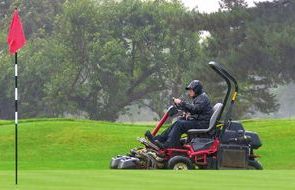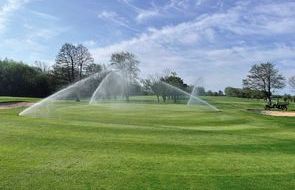- Homepage
- News and Features
- The greens at St Andrews: battling gales, securing victory
The greens at St Andrews: battling gales, securing victory
What is it they say about the best laid plans? Robert Burns wrote they “oft’ go awry”. You can make them. You can believe you will deliver them. You can have everything just as you want. But even at the Home of Golf on the Old Course during a major championship, you can’t legislate for the unexpected when the weather has other ideas. Murphy’s Law trumps all. When problems arise, sometimes plans have to go out the window.
It had all been going so well for Jon Wood. The course manager at the Old Course, just the 10th greenkeeper to hold the position in 160 years, had started his career in St Andrews working on the Women’s British Open in 2007.
Now the AIG Women’s Open was his first in charge of the historic links and his team had worked diligently to get the golf course singing in time for the August 2024 championship. “We’d done everything prior to the tournament,” he said, recalling the preparation when speaking at BIGGA’s massive turf management exhibition in Harrogate earlier this year.

“We’d got them exactly where the guys wanted them. The firmness was in and around 120. We were stimping about 10 foot six – exactly where we wanted on the Saturday night [before the start of the championship].”
Holding a tournament on one of the planet’s most popular courses is not straightforward. How do you protect the layout – ensuring it’s in the best condition for the event – when so many rounds are being played on it six days a week? And while the average driving distance on the LPGA Tour is around 260 yards, the differences between the biggest and shortest hitters in the women’s game means some competitors can be looking at the same sort of shot lengths as their male handicapper counterparts – the everyday ‘hackers’ chewing up those same tees and fairways every day.
The St Andrews team had to consider what to do with those tees and how to carefully manage pin positions they knew would be used come championship time. That’s not an easy task on some of the Old Course’s trickier putting surfaces. “The ladies don’t play off a lot of the championship tees – they’re playing off the more everyday tees,” Wood explained.
“So we had to start protecting those around eight to 10 weeks out. That causes challenges. Where do we put the tees for the guys who are playing and visiting St Andrews? Then there are the pin locations. A few of the greens can be quite challenging. There are not a lot of positions on 11, so you find some really interesting ones for general play. [But] You’re always trying to strive and produce the best you can every day.”
They had managed it too. Everyone was delighted. Until they saw the weather forecasts. For major championships like the AIG Women’s Open, The R&A have experts on site monitoring conditions and predicting, with largely unerring accuracy, what the elements might have in store.

Links maritime environments can be very volatile. It can be part of what makes the game fun for most of us, but it can have serious implications when the best players in the world are competing for major honours. What the forecasts were showing was wind. Not a gentle breeze but sustained gales – averages of 30mph on every day of the tournament and gusts potentially hitting more than 50mph. They’re the kind of conditions that hurl sand out of bunkers and get balls wobbling, and shooting off altogether, on fast greens. This wasn’t a one-off, an annoyance over a single round. This was coming every day of the AIG Women’s Open.
They’ve made subtle alterations to the Old Course agronomy over the past few years. Changes to grass composition help greenkeeping teams keep greens under control, even when it’s more than blustery.
But this was something else, and it required action. “It was very challenging,” Wood said. “We met every evening and, on the first, it was, ‘we need to slow the greens down’.” He added: “It’s about, ‘how are we going to do that?’ In my head, I want to run something over the greens.
“We had some pretty interesting conversations of how to do that through the week. Those things do keep you awake at night.

“One of the greens was hardly cut that week. In my head, I’m thinking, ‘what are these looking like on TV?’ I’m having sleepless nights. ‘What is everybody else in the world thinking about those greens?’ And I can’t do anything about it, because we need to get the tournament played.”
A Monday finish is a catastrophe. It’s horrendous for the players, who have flights booked and new places to be. It’s horrendous for spectators, who haven’t spent a second thinking about whether there would be a delay. It’s horrendous for the organisers, with huge numbers of staff delayed and a logistics plan that must be put on hold. In championship time, you move heaven and earth to ensure a Sunday finish.Wood’s team, along with The R&A’s Championship Agronomy experts, got to work. They lifted mowing heights on those greens most exposed to the wind on the Eden Estuary.
They cut them in the evening but left them the following morning – eschewing the usual double cut following play that would be a feature of championship weeks. They dialled it back, able to exercise that level of control because of the painstaking pre-tournament work from Wood and the Old Course greenkeeping team.
Good feeding plans, and ensuring the grass plant was strong and healthy, allowed them to adapt in the most challenging circumstances and ensure not only that the tournament was completed on time but good relations were maintained among everyone tasked with achieving that outcome.

Wood quipped: “We didn’t fall out, because that could have quite easily happened. There were quite frank conversations. We could have fallen out. To get golf through every day was a success,” he said.
“You start getting questions from your team, ‘why are we not cutting the greens today?’ You have to try and keep everyone on board with why we’re doing this. You have to explain that it’s because we need to get here by the end of the week.
“It’s still looking good and still producing surfaces. The numbers are still good. Although the green speed is going down, the smoothness and trueness was still where we wanted it. It was with great pride that we achieved it.
Grant Moir [The R&A’s executive director of governance] said to me in The R&A Clubhouse on the Sunday night after the presentation that it was one of the toughest events he’d ever done.
“That gave me a lot of pride.”
What to read next
How automation is transforming greenkeeping – without replacing greenkeepers
Tags
Author










